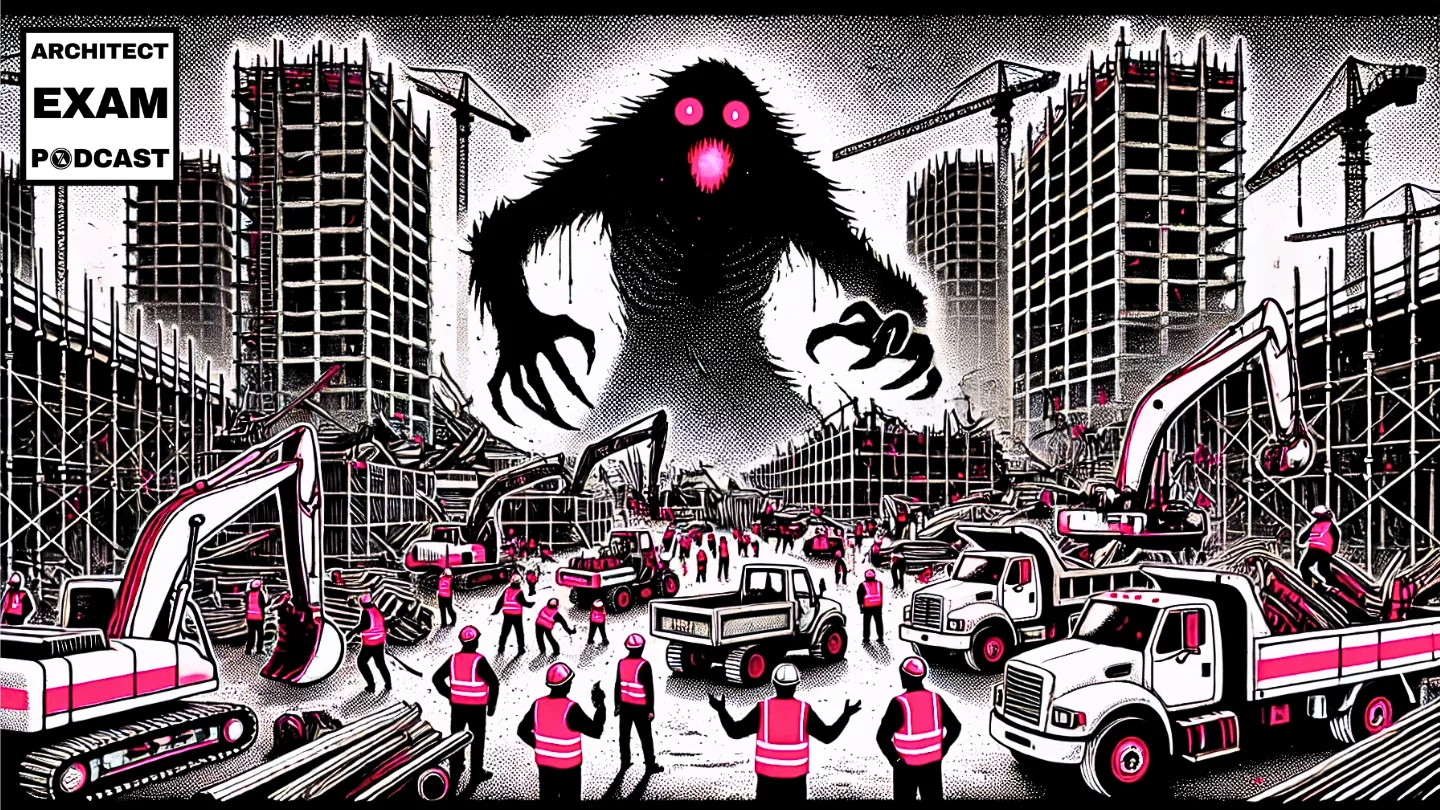In construction, the only certainty is that something unexpected will happen. A well-planned construction contingency is the difference between a project crisis and a manageable adjustment to your budget, schedule, and client expectations.
This podcast is also available on YouTube, Spotify, and Apple Podcasts
The Inevitable Challenge
In the world of construction, one truth remains constant: something will always go wrong. In fact, Murphy’s Law isn’t just a suggestion in construction—it’s the business model.
After graduating architecture school and starting at my first firm, I felt like every single project I worked on ran into problems. Budgets got blown, schedules slipped, contractors ignored drawings, and unknown site conditions derailed carefully made plans. With each issue, someone would get upset, and I’d find myself stressed and questioning my abilities.
Was I just bad at my job? Maybe architecture wasn’t for me? I’d lie awake at night wondering if I should switch to a less stressful career—like bomb disposal or alligator dentistry.
After several years, I finally learned two fundamental truths of project management:
- Unexpected problems are inevitable
- It’s always better to have extra time and money than to have to ask for more
These realizations changed how I approached every project. The unexpected isn’t a possibility in construction—it’s a guarantee. Material delays, unforeseen site conditions, clients changing minds after design is finalized, or even acts of God like lightning striking a construction site can happen on any project, regardless of how carefully you plan.
This is why understanding construction contingency isn’t just helpful—it’s essential for project success.
What Is a Construction Contingency?
A construction contingency is a strategic safety net—a reserve of money set aside to cover unexpected costs or unknown risks that emerge during a project.
Think of planning a road trip. You estimate gas, food, and lodging will cost $1,000. Do you bring exactly $1,000? Probably not. You set aside extra money in case gas prices rise, you decide to stay an extra night, or something unexpected happens. That extra money is your contingency.
Contingency planning is like having a spare phone charger—everyone laughs at you for carrying it until their phone dies and you become the most popular person in the room.
Contingencies aren’t always about money—they apply to time as well:
- Financial contingency: Reserved funds to cover unexpected costs
- Time contingency: Buffer periods built into schedules for delays or unexpected issues
For example, if a client needs to move into their building in 12 months, that doesn’t mean the contractor gets 12 months to finish the work. You might schedule construction for 9-10 months, leaving contingency time for delays, approvals, or last-minute issues.
Construction projects particularly need contingency planning because of:
- Complex coordination between multiple parties
- Dependency on external factors (weather, material availability)
- Hidden conditions that can’t be fully known until construction begins, despite thorough specification documents and site investigations
A well-planned contingency lets you handle surprises without derailing your plans, budget, or schedule. It’s not pessimism—it’s professionalism.
Who Carries the Contingency?
Everyone involved in a construction project should have contingency in some capacity to protect themselves from their specific risks:
Owner’s Contingency
Covers cost overruns, scope changes, and unforeseen site conditions. Some owners keep this contingency private to maintain control over spending. This is typically around 5-10% of construction costs, though it varies based on project complexity and whether you’re working with public or private clients.
Architect’s Contingency
A portion of the design fee set aside for unexpected redesign work, consultant coordination, or document errors/omissions. Architects might reserve 5-15% of their fee for contingency, depending on project type and familiarity.
Consultant’s Contingency
Engineers and other consultants include contingency for coordination issues or necessary design adjustments. Similar to architects, they typically set aside a portion of their fees to account for unknown factors.
Contractor’s Contingency
Built into bids to cover cost fluctuations, minor scope gaps, or unexpected site conditions. Contractors might include a 3-10% contingency depending on project complexity and the completeness of the documents.
Subcontractor’s Contingency
Adjusts pricing for labor shortages, material delays, or coordination problems. This is often built into their unit prices rather than as a separate line item.
Most contingency funds aren’t openly discussed. Once the project concludes, unused contingency either returns to the budget or becomes additional profit. But regardless of how it’s handled, having multiple layers of contingency helps protect all parties involved in the project.
The Golden Rule of Contingency Planning
When estimating contingency, follow this fundamental principle: The less confidence and information you have, the higher the contingency should be.
At the start of a project, almost everything is an unknown:
- The design isn’t complete
- Material costs aren’t finalized
- Site conditions haven’t been fully assessed
Because of this, contingency needs to be larger at the beginning, particularly during the preconstruction phase, when risk is highest. As the project progresses and more details get locked in, risks decrease, so contingency can be reduced accordingly.
Typical contingency percentages throughout the project lifecycle:
- Early design phase: 15-20% (high unknowns)
- Mid-design: 10-15% (moderate unknowns)
- Construction documents: 8-12% (lower unknowns)
- Construction phase: Gradually reducing contingency as work progresses
Real-World Example: The 20-Minute Fire Station Estimate
When I worked for the government as a project manager, politicians would frequently call our office: “What would it cost to build a new fire station? I need an answer before my budget meeting in 20 minutes.”
With such limited information, here’s what I’d do:
- Pull data from the last fire station we built
- Calculate hard and soft costs, land costs, taxes, and permit fees
- Add everything together
- Double it
- If the number still felt low, add another 20-40%
Why such high percentages? Because at that early stage, the uncertainties were enormous. No site had been selected, no program had been developed, and no design work had begun. The fire station might need to be built on expensive property requiring extensive site work, or it might need specialized equipment.
Remember the golden rule: It’s always better to have extra funds set aside than to scramble for more when something goes wrong.
Types of Contingencies in Construction
Different types of contingencies serve specific purposes throughout the project:
Financial Contingencies
- Design contingency: Covers design changes, additional consultant fees, or redesign work. Critical during schematic and design development phases.
- Bid contingency: Accounts for market fluctuations, labor availability, and material price changes that might occur during the construction bidding process between estimation and actual bidding.
- Construction contingency: Handles unforeseen conditions, coordination issues, or minor modifications during the building process.
- Owner’s contingency: Covers client-directed changes, program adjustments, or scope additions that the owner might request during construction.
Time Contingencies
- Schedule buffers: Built-in flexibility for weather delays or unexpected issues that might affect critical path activities.
- Approval contingencies: Extra time for permits, inspections, regulatory approvals, and project closeout, which often take longer than expected.
- Coordination contingencies: Buffer for multi-trade coordination or sequencing challenges, especially in complex areas like mechanical rooms.
The right type of contingency depends on your project delivery method:
- Design-Bid-Build: Typically requires higher contingencies due to the linear process and potential for gaps between design and construction.
- Design-Build: May have lower contingencies as a single entity manages both design and construction, reducing coordination issues.
- Construction Manager: Can help manage contingency more effectively through early contractor involvement, but still requires appropriate reserves.
Murphy’s Laws of Construction
The complexity of any construction problem is directly proportional to the number of people wishing for the project to complete faster. Some other unofficial laws I’ve discovered:
- The more important the client meeting, the more likely a major issue will be discovered the night before
- The clarity of construction documents is inversely proportional to the complexity of what’s being built
- Any drawing detail left ambiguous will be built in exactly the way you didn’t intend
Contingency vs. Allowance: Understanding the Difference
Contingencies and allowances are often confused, but they serve different purposes in construction budgeting:
Allowance
An allowance is a specific amount included in the contract sum for a defined item that’s not fully detailed at the time of pricing. Examples include:
- Material selection (flooring, finishes) where quality or type hasn’t been finalized
- Systems or equipment where the exact model hasn’t been specified
- Items where the quantity is unknown but will be measured during construction
Contingency
A contingency, in contrast, is for entirely unforeseen conditions or changes—things you can’t anticipate specifically.
The key differences:
- Purpose: Allowances are for known items with undefined details; contingencies are for unknown items
- Specificity: Allowances are assigned to specific items; contingencies are general reserves
- Control: Allowances are typically spent (just on what and how much remains uncertain); contingencies may not be used at all
- Documentation: Allowances appear as line items in the contract; contingencies may be built into pricing or kept separate
For example, you might include a $10,000 allowance for lobby finishes that haven’t been selected yet, but a 5% contingency for unforeseen conditions throughout the project.
Practical Risk Management: Turning Unknowns into Knowns
How do you plan for what you don’t know? Through systematic risk management:
1. Spot Risks Early
Before the project starts, brainstorm what could go wrong with budget, schedule, site conditions, design changes, or permitting. Make a comprehensive list of potential issues.
2. Categorize Risks
Group risks by type and priority:
- High impact/high probability: These need immediate planning and significant contingency
- High impact/low probability: These need contingency plans but may not affect baseline budgets
- Low impact/high probability: These should be factored into the base plan
- Low impact/low probability: These can be monitored but require less planning
3. Assess Probability and Impact
Assign a likelihood rating and potential cost/schedule impact to each risk. This helps prioritize which risks need the most attention.
4. Create Proactive Plans
For high-priority risks, develop specific strategies to:
- Avoid the risk entirely
- Mitigate its impact
- Transfer the risk (insurance, construction bonds, contractual provisions)
- Accept and plan for it with adequate contingency
5. Document Everything
Create a risk register that tracks:
- Risk description
- Potential impact
- Mitigation strategy
- Contingency allocated
- Person responsible for monitoring
On my first major renovation project, we found what the contractor casually described as a “small water issue” during demolition. No contingency meant three weeks of delays while we scrambled for approvals and redesign. Now I include what I mentally call the “Oh crap” line item in every budget—professionally labeled as “unforeseen conditions” of course.
Throughout the project, track contingency usage and regularly reassess risks. As specific risks are resolved, you can release that portion of contingency or reallocate it to new risks.
This systematic approach to risk identification and mitigation shares many principles with proper quality control procedures, another critical aspect of project success. This isn’t pessimism—it’s smart project management. Contingency planning transforms you from reactive crisis management to proactive planning.
Contingency Planning on the ARE Exam
For architects preparing for the Architect Registration Exam (ARE), understanding contingency is crucial across multiple divisions:
Practice Management (PcM)
- Business operations and financial risk management
- Project budget development
- Fee structures including contingency planning
Project Management (PjM)
- Budget development and monitoring
- Risk identification and mitigation
- Contract negotiations and provisions for contingency
Construction & Evaluation (CE)
- Construction phase contingency management
- Change order administration
- Project closeout and final contingency reconciliation
The ARE will test your understanding of appropriate contingency percentages and who controls different types of contingencies. A common exam scenario might present something like:
“Your client asks why they need to include a 10% contingency in their budget when the design is almost complete. How do you respond?”
The correct approach would emphasize:
- Specific risks that still exist at that phase
- Statistical likelihood of changes during construction
- Benefits of proactive planning vs. reactive crisis management
- Examples of how contingency protects all parties involved
Remember that on the exam, contingency isn’t just about money—it’s about demonstrating professional judgment and risk management capabilities.
Contingency Across ARE Divisions: What to Expect on Your Exams
The concept of contingency isn’t just a theoretical part of architecture—it’s a frequently tested topic across multiple ARE divisions. At Young Architect, we’ve created numerous practice questions specifically addressing contingency concepts because we know how critical this knowledge is for exam success.
Depending on which division you’re taking, contingency appears in different contexts:
- In PcM, you’ll face questions about appropriate fee structures and business contingency planning
- In PjM, expect scenarios about applying contingency to different project phases
- In CE, you may need to address construction contingency management in change orders
These questions often present real-world scenarios where you need to determine the appropriate type and amount of contingency. Some questions might ask you to identify who should be carrying specific contingencies, while others test your understanding of when to use—or release—contingency funds.
Understanding these concepts thoroughly before your exam isn’t optional—it’s essential preparation that can make the difference between passing and failing multiple divisions. Our ARE 101 course materials include targeted practice questions that help you master these concepts in the specific context of each exam division.
How Different Professions Handle Contingency
It’s interesting how different professions approach the unexpected:
- Doctors build in contingency by scheduling 15-minute appointments for 10-minute problems
- Lawyers charge by the hour, so their contingency is built into the billing system
- Chefs keep backup ingredients for when things go wrong
- Construction professionals just develop a nervous twitch when someone says “this is a simple project”
Beyond Construction: Contingency as a Life Skill
Planning for the unknown isn’t just a construction skill—it’s a life skill. The contingency mindset can be applied across many situations:
- Personal finance: Creating emergency funds for unexpected expenses
- Time management: Leaving early for the airport to account for traffic or TSA delays
- Travel planning: Bringing extra cash or a backup credit card when traveling
- Home ownership: Keeping spare keys hidden in case you lock yourself out
- Business planning: Maintaining cash reserves for unexpected downturns
The contingency mindset transforms your approach to risk:
- From reactive crisis management to proactive planning
- From anxiety about the unknown to confidence in your preparation
- From viewing contingency as “wasted money” to seeing it as essential insurance
The universal principle applies: The more unpredictable the situation, the more contingency you need.
Construction contingency is a lot like having children—no matter how much you plan, you’ll still be surprised, and it will probably cost more than you expected. But just like with kids, proper planning makes the unexpected moments manageable rather than catastrophic.
And for those who love formulas, here’s my unofficial contingency calculation:
Estimated time × client indecisiveness factor × number of stakeholders = Actual time needed
Once you start thinking this way, contingency planning becomes second nature—not just in construction, but in any project or decision. This approach will serve you well both on the ARE exam and throughout your professional career.
ARE Bootcamp: Your Exam Contingency Plan
When you think about it, there’s a striking parallel between construction contingency and preparing for the Architect Registration Exam. Just like construction projects face inevitable unknowns, the path to licensure contains challenges you can’t anticipate—especially if you’ve never taken these exams before.
Many candidates approach the ARE thinking they can study on their own, only to discover gaps in their knowledge when exam results come back. This reactive approach often leads to:
- Paying additional fees for retakes
- Extending your time to licensure by months or even years
- Experiencing the frustration and confidence loss that comes with failure
This is precisely why I developed the ARE Bootcamp program—to serve as your “exam contingency plan.” Just as a well-planned construction contingency protects against project failure, ARE Bootcamp provides insurance against the high costs and delays associated with exam failures.
The golden rule of contingency applies perfectly here: The less experience you have, the more protection you need. If you’ve never taken these exams before, you simply don’t know what you don’t know—which means your “knowledge contingency” needs to be substantial.
ARE Bootcamp provides this protection through:
- Structured curriculum that covers all exam content
- Community support that offers multiple perspectives on challenging concepts
- Accountability systems that keep you on track
- Expert guidance from those who have “seen it all” with the exams
Is it an investment? Absolutely. But like any good contingency plan, it’s far less expensive than the alternative—months of additional study time, multiple retake fees, and delayed career advancement.
Remember: In construction and in exam preparation, it’s always better to plan for the unknown than to react to it. ARE Bootcamp isn’t just another study resource—it’s your strategic contingency against exam failure.
Embracing the Unknown
In construction, the question isn’t if something will go wrong, but when—and how prepared you’ll be when it does.
We’ve explored how construction contingency works as a vital planning tool:
- Everyone involved should carry appropriate contingencies to protect against their specific risks
- Higher unknowns require higher contingencies, which decrease as projects progress
- Contingency planning is an ongoing process requiring regular reassessment
- Proper contingency management converts chaos into manageable challenges
Contingency planning isn’t pessimism—it’s professionalism. The best project managers don’t just hope for the best; they prepare for reality.
As you prepare for your exams, understand not just what contingency is, but how to apply it strategically throughout a project’s lifecycle.
For professionals managing projects today: Have you identified the key risks? Is your contingency appropriate for your current project phase? Have you created a clear plan for managing the unknown?
By mastering the art of contingency planning, you’ll not only improve your projects’ outcomes but also reduce the stress and uncertainty that comes with the inevitable surprises of construction. Because while we can’t predict exactly what will go wrong, we can ensure we’re prepared when it does.



